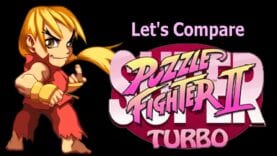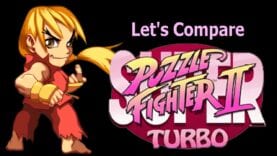Let’s Compare ( Super Puzzle Fighter 2 Turbo )
Gaming History Source
Video Locations:
1. Arcade 0:35
2. Gameboy Advance 4:03
3. Playstation 7:32
4. Playstation Portable 11:00
( Capcom Puzzle World )
5. Dreamcast 15:21
6. Saturn 18:58
Description Source:
https://en.wikipedia.org/wiki/Super_Puzzle_Fighter_II_Turbo
Super Puzzle Fighter II Turbo, released in Japan as Super Puzzle Fighter II X (Japanese: スーパーパズルファイターII X?) and commonly referred to as Puzzle Fighter, is a one or two player tile-matching puzzle video game first released in the spring of 1996 by Capcom on the CPS II arcade system. The game ’s title is a parody of Super Street Fighter II Turbo (or Super Street Fighter II X in Japan), as there are no other Puzzle Fighter games, and the game includes music and interface elements spoofing the Street Fighter Alpha and Darkstalkers games. It was a response to SEGA’s popular Puyo Puyo 2 that has been sweeping Japanese arcade.
A HD-remake version titled Super Puzzle Fighter II Turbo HD Remix, is available for purchase on Microsoft’s Xbox Live Arcade and Sony’s PlayStation Network.
Gameplay:
Puzzle Fighter is a puzzle game which is inspired by the Capcom arcade game Pnickies and Sega arcade game Baku Baku Animal.[citation needed] As in that game, the player controls pairs of blocks (“gems” in game parlance) that drop into a pit-like playfield (twelve blocks tall by six blocks wide, with the fourth column from the left being thirteen blocks high). In Puzzle Fighter, however, gems can only be eliminated by coming into contact with a Crash Gem of the same color, which eliminates all adjacent gems of that color, setting up the potential for huge chain reactions. As gems are eliminated, “garbage blocks” called Counter Gems will drop into the opponent’s playfield; these will eventually become normal gems, but only after they count down to zero (most Counter Gems start at “5” and are reduced by one each time a new pair of gems is dropped on that board), and until that time they cannot be eliminated by normal means. (The only way to eliminate Counter Gems before they become normal gems is to place a Crash Gem of that color nearby so it eliminates at least one normal gem. If this is done, all Counter Gems immediately adjacent to the Crash Gem will be taken out as well). Additionally, gems of the same color that form squares or rectangles (of at least two blocks tall and wide) in the pit become a giant Power Gem of that size and color; eliminating these as part of a combo increases the number of Counter Gems that would otherwise normally appear on the opponent’s board. The only other type of piece to appear is a diamond, which eliminates all the gems—normal, Power, Counter, and Crash alike—of whichever color gem it lands on. (This, too, will cause Counter Gems to appear on the opponent’s board. The diamond is supposed to create half the number of Counter Gems as a normal chain reaction. However, there is a bug that allows players to bypass this reduction.[1]). The diamond piece appears every 25 pieces.
Puzzle Fighter borrowed rules originally found in Puyo Puyo 2 called Sousai (Garbage Countering). This will allow a player to counter and negate garbage being sent by the opponent with chains of their own. Sousai can also be used to send garbage back to the opponent, known as Garbage overflow.
During the game, super deformed versions of various characters from Capcom’s two main fighting game series (Street Fighter and Darkstalkers), will act out a comical battle based on how the game is going. Every time one player sends Counter Gems to his or her opponent, his or her character will perform a typical fighting-game action, anything from a taunt to a special move. The more Counter Gems the player sends over, the “bigger” the move the character will perform. These animations, however, are purely cosmetic and have no actual bearing on the gameplay (other than to indicate the magnitude of the counters).
The game continues until one player’s field reaches the top of its fourth column (which is where all new gems first appear). That player is the loser.
HD Remix was announced to include several graphical upgrades in the interface, character sprites, levels, and endings, as well as the three gameplay modes included in the Dreamcast version; X-Mode, Y-Mode, and Z-Mode. Whereas X-mode is more of a rebalanced version of the core game, Y-Mode and Z-Mode have more drastic gameplay changes. Y-Mode makes the gems break as soon as three or more are aligned in a row, column, or diagonally, like in Columns, whereas Z-mode makes lines of gems rise up from the bottom of the screen, and the player controls a 2×2 square cursor, with which he rotates already-placed pieces, similarly to Tetris Attack.















